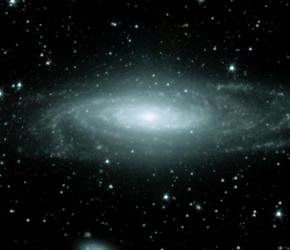This is according to a new and more accurate assessment. The estimate so far has been in the range between 750 billion suns and 2 trillion

The mass of the Milky Way was previously estimated at 750 billion solar masses and then the estimate was raised to 2 trillion (trillion = million millions - ten to the power of 12). However, now astronomers used more subtle methods and discovered that the mass of our galaxy is slightly less than a trillion solar masses. This is according to a study that will soon be published in the Astrophysical Journal.
The mass of the galaxy is distributed between stars, gas, dust and dark matter. The new estimates are based on a large sample of stars in the galaxy's halo, a relatively star-sparse region surrounding the galaxy's disk. The velocity of the stars in the halo reveals the mass of the galaxy as it is affected by the rate of gravity required to keep these stars in orbit around the center of the galaxy.
"The galaxy is thinner than we thought," says Xiangxiang Zui of the National Astronomical Observatory of China, who led an international team of researchers. "This means there is less dark matter in the galaxy than we previously thought, but it is also more efficient at turning the initial supply of hydrogen and helium into stars."
The findings, based on data from the SLOAN digital sky observatory, have far-reaching implications for our understanding of the Milky Way. the researchers write. "The total mass of the galaxy is difficult to measure because we are stuck inside it" explains Timothy Beers from the University of Michigan. "But this is the most important basic number that we must know to understand how the Milky Way galaxy was formed and to compare it to other galaxies that we see from the outside."
The previous estimates were based on 500 objects and less. The new calculation is based on mass and motion data of 2,400 stars. "The larger the database, the greater our statistical advantage," said Hans-Walter Ricks of the Max Planck Institute for Astronomy in Heidelberg, Germany and a research partner.

8 תגובות
To Michael
I got
Sabdarmish Yehuda
Yehuda:
The innovation is exactly the measurements.
That's what the article says.
That the new measurements do not contradict the estimates made in the past means that the past estimates were made responsibly.
I don't understand what is the novelty here, after all we have always claimed that the mass of the spiral galaxy should be ten times its visible mass and since its visible mass is about one hundred to two hundred billion solar masses, then ten times is what should be here, that is, between a trillion and two trillion.
I will not enter into an argument if there is even a dark mass.
Have a good day
Sabdarmish Yehuda
Strong:
There are stars outside galaxies but they are usually those that formed inside galaxies and were thrown out of them.
If you search on this website, you will find an article about a star in the Milky Way that, based on the direction and speed of its movement, the astronomers concluded that it was formed in the Magellanic Cloud (and probably stayed at some point between the two galaxies)
Indeed, this is what I mean, suns or if there is anything at all in the space between the galaxies.
Eitan, star = sun.
Labi, the editor of the website Freckles, is preparing for the launch of Discovery
Not so related but I wonder if there are stars outside galaxies. Have such phenomena been observed?